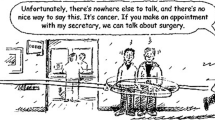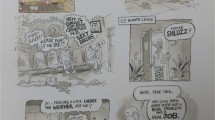Abstract
Non-fiction graphic novels about illness and death created by patients and their loved ones have much to teach all readers. However, the bond of empathy made possible in the comic form may have special lessons for healthcare providers who read these texts and are open to the insights they provide.





















Similar content being viewed by others
References
Charon, Rita. 2006. Narrative Medicine: Honoring the Stories of Illness. New York: Oxford University Press.
Czerwiec, MK. 2004. Scars, Stories, and Other Adventures. Chicago: MK Czerwiec Productions, www.comicnurse.com.
Farmer, Joyce. 2010. Special Exits: A Graphic Memoir. Seattle: Fantagraphics.
Gardner, Jared. 2008. “Autography’s Biography, 1972–2007.” Biography 31(1): 1–26.
Gravett, Paul. 2011. “The History of Graphic Medicine.” Keynote given at Comics & Medicine: The Sequential Art of Illness, Chicago, Illinois, June 10.
Green, Michael and Kimberly Myers. 2010. “Graphic Medicine: Use of Comics in Medical Education and Patient Care.” British Medical Journal 340: 574–577.
Leavitt, Sarah. 2010. Tangles: A Story About Alzheimer’s, My Mother, and Me. Calgary: Freehand.
Mackintosh, Ross. 2011. Seeds. London: Com.x.
McCloud, Scott. 1993. Understanding Comics: The Invisible Art. Northampton, MA: Tundra Publishing.
Nussbaum, Martha C. 1992. Love’s Knowledge: Essays on Philosophy and Literature. New York: Oxford University Press.
Sontag, Susan. 1978. Illness as Metaphor. New York: Farrar, Straus, Giroux.
Vankin, Deborah. 2010. “R. Crumb: Joyce Farmer’s ‘Special Exits’ on par with ‘Maus.’” Los Angeles Times, November 28, Hero Complex.
Williams, Ian. 2011. “Autography as Auto-Therapy: Psychic Pain and the Graphic Memoir.” Journal of Medical Humanities 32: 353–366.
Wright, Aneurin. 2012. Things to Do in a Retirement Home Trailer Park…When You’re 29 and Unemployed. Brighton: Myriad Editions.
Author information
Authors and Affiliations
Corresponding author
Rights and permissions
About this article
Cite this article
Czerwiec, M., Huang, M.N. Hospice Comics: Representations of Patient and Family Experience of Illness and Death in Graphic Novels. J Med Humanit 38, 95–113 (2017). https://doi.org/10.1007/s10912-014-9303-7
Published:
Issue Date:
DOI: https://doi.org/10.1007/s10912-014-9303-7




